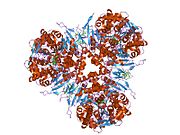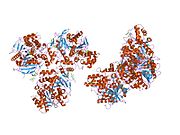카르복실레스테라아제 1
Carboxylesterase 1| CES1 | |||||||||||||||||||||||||
|---|---|---|---|---|---|---|---|---|---|---|---|---|---|---|---|---|---|---|---|---|---|---|---|---|---|
 | |||||||||||||||||||||||||
| |||||||||||||||||||||||||
| 식별자 | |||||||||||||||||||||||||
| 별칭 | CES1, ACAT, CE-1, CEH, CE2, HMSE1, PCE-1, REH, SES1, TGH, HCE-1, 카복실세라제 1 | ||||||||||||||||||||||||
| 외부 ID | OMIM: 114835 MGI: 2148202 HomoloGene: 35606 GeneCard: CES1 | ||||||||||||||||||||||||
| EC 번호 | 3.1.1.1 | ||||||||||||||||||||||||
| |||||||||||||||||||||||||
| |||||||||||||||||||||||||
| |||||||||||||||||||||||||
| |||||||||||||||||||||||||
| 직교체 | |||||||||||||||||||||||||
| 종 | 인간이다. | 마우스 | |||||||||||||||||||||||
| 엔트레스 | |||||||||||||||||||||||||
| 앙상블 | |||||||||||||||||||||||||
| 유니프로트 | |||||||||||||||||||||||||
| RefSeq(mRNA) | |||||||||||||||||||||||||
| RefSeq(단백질) | |||||||||||||||||||||||||
| 위치(UCSC) | Cr 16: 55.8 – 55.83Mb | Chr 8: 93.89 – 93.92Mb | |||||||||||||||||||||||
| PubMed 검색 | [3] | [4] | |||||||||||||||||||||||
| 위키다타 | |||||||||||||||||||||||||
| |||||||||||||||||||||||||
간 카르복실체테라아제 1(CES1, hCE-1 또는 CES1A1)은 인간에서 CES1 유전자에 의해 인코딩되는 효소다.[5][6]이 단백질은 역사적으로 세린 에스테라아제 1(SES1), 모노키테아제, 콜레스테롤 에스테라아제(CEH)로도 알려져 있다.이 유전자에 대해 세 가지 다른 ISO 양식을 인코딩하는 세 가지 대본 변형이 발견되었다.[6]ossoform a, b, c의 다양한 단백질 생산물은 각각 568, 567, 566개의 아미노산 크기부터 다양하다.
CES1은 간에서 더 높은 레벨과 위장에서 낮은 레벨을 가진 대부분의 조직에 존재한다.[7]
함수
카르복실세테라제 1은 세린 에스테라제로서 다량 카복시테라제 계열의 구성원이다.또한 알파/베타 접이식 하이드롤라제 계열에 속한다.[7]이 효소들은 에스테르와 아미드 본드를 함유하고 있는 유전생균과 코카인과 헤로인과 같은 약물의 가수분해를 담당한다.그들은 또한 긴 사슬의 지방산 에스테르와 티오스터를 가수 분해한다.2단계 신진대사의 일부로서, 그 결과로 생긴 카르복실산은 용해도를 증가시키기 위해 종종 다른 효소에 의해 결합되고 결국 배설된다.
이 효소는 방향제 및 편백 에스테르를 가수 분해하는 것으로 알려져 있으며 세포 콜레스테롤 에스테르화 수준을 관리할 수 있다.또한 에스테르 또는 아미드 화합물로부터 중추신경계를 보호하거나 폐에서 해독하는 역할도 할 수 있다.[6]
단백질은 아미노산 염기서열을 KDEL 수용체에 결합할 수 있는 내소성 망막으로 보내는 N-terminus에 아미노산 염기서열을 포함한다.[7]
임상적 유의성
카복실세테라아제 1 결핍은 비호지킨 림프종 또는 B세포 림프구 백혈병과 관련될 수 있다.특히 유기인산염에 의한 CES1의 억제는 단세포에 의한 종양 죽이기 활동을 감소시킨다.[8][9]단세포에서 이 단백질의 손실은 유기인산염 중독의 한 가지 산물이다.[9]
CES1은 다양한 약물을 활성화하거나 비활성화할 수 있다.CES1은 Angiotensin-converting 효소(ACE) 억제제, 오셀타미비르, 다비가트란과 같은 많은 프로드약물의 활성화를 담당한다.[10][11][12][13]CES1의 유전적 변형은 메틸페니다이트와 클로피도그렐과 같이 CES1이 대사하는 약물의 약동학 및 약동역학 모두에 유의미한 영향을 미칠 수 있다.[14]헤로인과 코카인을 대사하는 CES1의 능력은 효소에 대한 치료적 역할을 제안했다.[15]
대화형 경로 지도
| 각 기사에 연결하려면 아래의 유전자, 단백질, 대사물을 클릭하십시오.[§ 1] Fluorouracil(5-FU) 활동 편집
| 각 기사에 연결하려면 아래의 유전자, 단백질, 대사물을 클릭하십시오. [§ 1] |
참조
- ^ a b c ENSG00000262243 GRCh38: 앙상블 릴리스 89: ENSG00000198848, ENSG00000262243 - 앙상블, 2017년 5월
- ^ a b c GRCm38: 앙상블 릴리스 89: ENSMUSG000056973 - 앙상블, 2017년 5월
- ^ "Human PubMed Reference:". National Center for Biotechnology Information, U.S. National Library of Medicine.
- ^ "Mouse PubMed Reference:". National Center for Biotechnology Information, U.S. National Library of Medicine.
- ^ Zschunke F, Salmassi A, Kreipe H, Buck F, Parwaresch MR, Radzun HJ (Aug 1991). "cDNA cloning and characterization of human monocyte/macrophage serine esterase-1". Blood. 78 (2): 506–12. doi:10.1182/blood.V78.2.506.506. PMID 2070086.
- ^ a b c "Entrez Gene: CES1 carboxylesterase 1 (monocyte/macrophage serine esterase 1)".
- ^ a b c Imai T (Jun 2006). "Human Carboxylesterase Isozymes: Catalytic Properties and Rational Drug Design". Drug Metabolism and Pharmacokinetics. 21 (3): 173–185. doi:10.2133/dmpk.21.173. PMID 16858120.
- ^ Oertel J, Hagner G, Kastner M, Huhn D (Dec 1985). "The relevance of alpha-naphthyl acetate esterases to various monocyte functions". Br J Haematol. 61 (4): 717–26. doi:10.1111/j.1365-2141.1985.tb02886.x. PMID 4084460. S2CID 84899499.
- ^ a b Markey GM (Feb 2011). "Carboxylesterase 1 (Ces1): from monocyte marker to major player". J Clin Pathol. 64 (2): 107–9. doi:10.1136/jcp.2010.084657. PMID 21177752. S2CID 32622794.
- ^ Zhu HJ, Appel DI, Johnson JA, Chavin KD, Markowitz JS (Jan 2009). "Role of carboxylesterase 1 and impact of natural genetic variants on the hydrolysis of trandolapril". Biochem Pharmacol. 77 (7): 1266–72. doi:10.1016/j.bcp.2008.12.017. PMID 19185566.
- ^ Thomsen R, Rasmussen HB, Linnet K, INDICES Consortium (Jan 2014). "In vitro drug metabolism by human carboxylesterase 1: focus on angiotensin-converting enzyme inhibitors". Drug Metab Dispos. 42 (1): 126–33. doi:10.1124/dmd.113.053512. PMID 24141856. S2CID 206496779.
- ^ Zhu HJ, Markowitz JS (Feb 2009). "Activation of the antiviral prodrug oseltamivir is impaired by two newly identified carboxylesterase 1 variants". Drug Metab Dispos. 37 (2): 264–7. doi:10.1124/dmd.108.024943. PMID 19022936. S2CID 9277216.
- ^ Paré G, Eriksson N, Lehr T, Connolly S, Eikelboom J, Ezekowitz MD, Axelsson T, Haertter S, Oldgren J, Reilly P, Siegbahn A, Syvanen AC, Wadelius C, Wadelius M, Zimdahl-Gelling H, Yusuf S, Wallentin L (Apr 2013). "Genetic determinants of dabigatran plasma levels and their relation to bleeding". Circulation. 127 (13): 1404–12. doi:10.1161/CIRCULATIONAHA.112.001233. PMID 23467860.
- ^ Zhu HJ, Patrick KS, Yuan HJ, Wang JS, Donovan JL, DeVane CL, Malcolm R, Johnson JA, Youngblood GL, Sweet DH, Langaee TY, Markowitz JS (Jun 2008). "Two CES1 gene mutations lead to dysfunctional carboxylesterase 1 activity in man: clinical significance and molecular basis". Am J Hum Genet. 82 (6): 1241–8. doi:10.1016/j.ajhg.2008.04.015. PMC 2427248. PMID 18485328.
- ^ Redinbo MR, Bencharit S, Potter PM (Jun 2003). "Human carboxylesterase 1: from drug metabolism to drug discovery". Biochem Soc Trans. 31 (Pt 3): 620–4. doi:10.1042/bst0310620. PMID 12773168.
추가 읽기
- Riddles PW, Richards LJ, Bowles MR, Pond SM (1992). "Cloning and analysis of a cDNA encoding a human liver carboxylesterase". Gene. 108 (2): 289–92. doi:10.1016/0378-1119(91)90448-K. PMID 1748313.
- Munger JS, Shi GP, Mark EA, et al. (1991). "A serine esterase released by human alveolar macrophages is closely related to liver microsomal carboxylesterases". J. Biol. Chem. 266 (28): 18832–8. doi:10.1016/S0021-9258(18)55139-5. PMID 1918003.
- Long RM, Calabrese MR, Martin BM, Pohl LR (1991). "Cloning and sequencing of a human liver carboxylesterase isoenzyme". Life Sci. 48 (11): PL43–9. doi:10.1016/0024-3205(91)90515-D. PMID 1997784.
- Ketterman AJ, Bowles MR, Pond SM (1990). "Purification and characterization of two human liver carboxylesterases". Int. J. Biochem. 21 (12): 1303–12. doi:10.1016/0020-711X(89)90149-3. PMID 2612723.
- Becker A, Böttcher A, Lackner KJ, et al. (1994). "Purification, cloning, and expression of a human enzyme with acyl coenzyme A: cholesterol acyltransferase activity, which is identical to liver carboxylesterase". Arterioscler. Thromb. 14 (8): 1346–55. doi:10.1161/01.atv.14.8.1346. PMID 8049197.
- Kroetz DL, McBride OW, Gonzalez FJ (1993). "Glycosylation-dependent activity of baculovirus-expressed human liver carboxylesterases: cDNA cloning and characterization of two highly similar enzyme forms". Biochemistry. 32 (43): 11606–17. doi:10.1021/bi00094a018. PMID 8218228.
- Shibata F, Takagi Y, Kitajima M, et al. (1993). "Molecular cloning and characterization of a human carboxylesterase gene". Genomics. 17 (1): 76–82. doi:10.1006/geno.1993.1285. PMID 8406473.
- Langmann T, Becker A, Aslanidis C, et al. (1997). "Structural organization and characterization of the promoter region of a human carboxylesterase gene". Biochim. Biophys. Acta. 1350 (1): 65–74. doi:10.1016/S0167-4781(96)00142-X. PMID 9003459.
- Brzezinski MR, Spink BJ, Dean RA, et al. (1997). "Human liver carboxylesterase hCE-1: binding specificity for cocaine, heroin, and their metabolites and analogs". Drug Metab. Dispos. 25 (9): 1089–96. PMID 9311626.
- Yan B, Matoney L, Yang D (1999). "Human carboxylesterases in term placentae: enzymatic characterization, molecular cloning and evidence for the existence of multiple forms". Placenta. 20 (7): 599–607. doi:10.1053/plac.1999.0407. PMID 10452915.
- Mori M, Hosokawa M, Ogasawara Y, et al. (1999). "cDNA cloning, characterization and stable expression of novel human brain carboxylesterase". FEBS Lett. 458 (1): 17–22. doi:10.1016/S0014-5793(99)01111-4. PMID 10518925. S2CID 5792413.
- Islam MR, Waheed A, Shah GN, et al. (1999). "Human egasyn binds beta-glucuronidase but neither the esterase active site of egasyn nor the C terminus of beta-glucuronidase is involved in their interaction". Arch. Biochem. Biophys. 372 (1): 53–61. doi:10.1006/abbi.1999.1449. PMID 10562416.
- Ghosh S (2001). "Cholesteryl ester hydrolase in human monocyte/macrophage: cloning, sequencing, and expression of full-length cDNA". Physiol. Genomics. 2 (1): 1–8. doi:10.1152/physiolgenomics.2000.2.1.1. PMID 11015575.
- Ghosh S, Natarajan R (2001). "Cloning of the human cholesteryl ester hydrolase promoter: identification of functional peroxisomal proliferator-activated receptor responsive elements". Biochem. Biophys. Res. Commun. 284 (4): 1065–70. doi:10.1006/bbrc.2001.5078. PMID 11409902.
- Alam M, Ho S, Vance DE, Lehner R (2002). "Heterologous expression, purification, and characterization of human triacylglycerol hydrolase". Protein Expr. Purif. 24 (1): 33–42. doi:10.1006/prep.2001.1553. PMID 11812220.
- Satoh T, Taylor P, Bosron WF, et al. (2002). "Current progress on esterases: from molecular structure to function". Drug Metab. Dispos. 30 (5): 488–93. doi:10.1124/dmd.30.5.488. PMID 11950776.
- Alam M, Vance DE, Lehner R (2002). "Structure-function analysis of human triacylglycerol hydrolase by site-directed mutagenesis: identification of the catalytic triad and a glycosylation site". Biochemistry. 41 (21): 6679–87. doi:10.1021/bi0255625. PMID 12022871.
- Strausberg RL, Feingold EA, Grouse LH, et al. (2003). "Generation and initial analysis of more than 15,000 full-length human and mouse cDNA sequences". Proc. Natl. Acad. Sci. U.S.A. 99 (26): 16899–903. doi:10.1073/pnas.242603899. PMC 139241. PMID 12477932.
- Bencharit S, Morton CL, Xue Y, et al. (2003). "Structural basis of heroin and cocaine metabolism by a promiscuous human drug-processing enzyme". Nat. Struct. Biol. 10 (5): 349–56. doi:10.1038/nsb919. PMID 12679808. S2CID 1108060.
- Zhu HJ, Brinda B, Froehlich TE, Markowitz JS (2012). "A discriminative analytical method for detection of CES1A1 and CES1A2/CES1A3 genetic variants". Pharmacogenet Genomics. 22 (3): 215–8. doi:10.1097/FPC.0b013e32834f03eb. PMC 3412537. PMID 22237548.





















